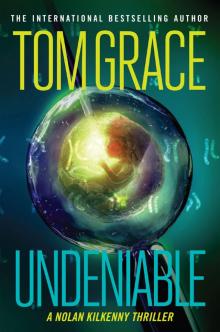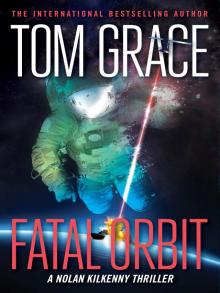Fatal Orbit Read online
Page 3
Barely a half-minute into the flight, with the aerodynamic pressure bearing down on the shuttle racing toward Max Q, Lundy announced he was throttling back the main engines to 85 percent. The shuttle slowed just enough to keep the stresses bearing down on the spacecraft from exceeding the safety limit. Thirty seconds later, Kelsey heard Lundy’s voice again.
“Control, this is Liberty. Throttling up.”
“Roger, Liberty. Throttle up.”
The beach party in Jetty Park had paused as launch time neared. As they did at New Year’s, many of the revelers were counting down the final seconds. Nolan slid the phone back into his pocket and stood silently near the water’s edge, staring at a faint glow of artificial lights far behind the silhouetted mangrove forest on the opposite shore.
The shuttle rose like a false dawn, the fire plume beneath her glowing white-hot against the night sky, impossible to miss. The people on the beach cheered and clapped as Liberty ascended. Nolan smiled, silently sharing their enthusiasm.
As the shuttle rolled into its eastward arc, it surprised him to discover that, at a distance of only a few miles, he couldn’t hear the roar of those immense engines. He could easily distinguish the four main components of the shuttle and had assumed that any explosive force powerful enough to hurl the equivalent of a thirteen-story building into orbit should make a proportional amount of noise.
Thirty seconds after Liberty appeared above the mangroves, the thunder of the launch hit the beach. Panicked flights of birds bolted from the trees and Nolan quickly realized that he was distant enough to see the launch well before he heard it.
His eyes followed the line of smoke and fire across the night sky until, at last, he lost it in the stars. With the show complete, the other spectators began drifting back to their cars, another workday to face in the morning.
Nolan understood the dangers Kelsey faced, working in a dangerous environment where equipment failure can quickly lead to death. In his days as a Navy SEAL, he had spent a lot of time in the confined space of submarines, and had swum from the ocean depths onto many hostile shores.
At least no one up in space is trying to kill you, Nolan thought. He remained on the beach, watching the heavens.
CHAPTER THREE
LIBERTY
AUGUST 3
Kelsey floated near the ceiling of the flight-deck, her fingers wrapped around a handhold to prevent her from drifting as she gazed out the overhead windows. The orbiter was flying inverted over the Earth, but the illusion of zero gravity rendered the distinction between up and down irrelevant. The physicist part of her brain reminded her that it was Earth’s gravity that held the shuttle in orbit and that its effect at this altitude was almost 90 percent of what she normally experienced every day of her life.
In terms of scale, she realized, she really hadn’t traveled all that far. If the Earth were the size of a basketball, then Liberty would be a tiny speck skimming less than a quarter-inch above the surface. What kept the shuttle from falling back to Earth or careening out into space was a delicate balance of speed and gravity. At 17,500 miles per hour, Liberty was falling around the Earth, rather than into it. As a consequence, Kelsey and her fellow astronauts were continuously experiencing the instant of weightlessness one briefly feels when bouncing on a trampoline.
Kelsey stared, transfixed by the iridescent blues of the Pacific Ocean. Twenty minutes earlier, she saw the Godavari and Ganges Rivers flash briefly in the sunlight, like veins of silver etched into the landmass of the subcontinent. It was midday on the world beneath her, but already her sense of connection to an earthly time and place was gone. Since arriving in space, Kelsey had witnessed a week’s worth of dazzling sunrises—an event that, from Liberty’s point of view, occurred every ninety minutes.
Like everyone else onboard, Kelsey had shed her helmet and spacesuit as soon as they reached orbit. She wore shorts, a T-shirt and padded socks—standard NASA-issue for this work environment. Her long mane of straight blond hair was tied back in a French braid to keep it under control. Molly and Valentina floated beside her at the observation windows, staring wide-eyed at the planet below.
“What do you think of the view, ladies?” Lundy asked as he floated up through an interdeck access hatch onto the flight-deck, followed by Tosh.
“It’s still the most exquisite thing I’ve ever seen,” Molly answered in a soft Irish brogue, not taking her eyes from the window. “Simply breathtaking.”
“Da,” Valentina added, transfixed. “Magnificent.”
“There’s Hawaii,” Kelsey said. She then thought of Nolan, who was working on a project there.
“Seeing the world like this is definitely one of the perks of this job,” Lundy concurred. “This is my fifth trip up and I still ain’t bored with it. ’Course you’ll log a bunch more hours in orbit than I got by the time your stint is through. When you return, let me know if you got tired of looking down on us.”
“I can’t imagine that ever happening,” Kelsey replied.
Molly checked her watch and was surprised at how quickly the time had passed at the window. “I presume you’re here to roll the orbiter over for the EVA?”
Lundy nodded. This EVA—extravehicular activity, NASA-speak for a spacewalk—was the first of two planned for this mission. The first was to launch the communications satellite, the second to install the array at the ISS.
“All good things,” Molly sighed. “Sister Valentina, we’d best pop down and give our crewmates a hand with the EMUs.”
“Yes, Mother Superior.”
With two fingers, Valentina gently pushed off from the ceiling, twisted in midair and effortlessly glided through the access hatch. Molly followed her down, though with considerably less aplomb.
“Looks like Val’s got her space-legs back quickly,” Tosh commented.
“I don’t think on my best day in space that I ever made moving around look that easy. That lady has a real knack for microgravity.” Lundy turned to Kelsey. “How are you feeling?”
“Better. The first twelve hours were a little rough.”
“Usually are. Say, what was that Mother Superior thing all about?”
Kelsey smiled. “Inside joke. During our preparation for ISS, Molly was really putting us through our paces, so the other girls and I nicknamed her Mother Superior. As it turns out, Molly has a pretty good sense of humor and she ran with the idea.”
“So now all the rest of you are …”
“Sisters of the Most Holy Celestial Convent,” Kelsey offered reverently.
“I guess that’s better than being called the Vestal Virgins,” Tosh said.
“This group of women? I don’t think so.”
“Things are going to be cramped on middeck for a little bit, so it’s probably best you stay up here with us. And you might want to grab hold of something when we fire the thrusters.”
“Thanks,” Kelsey replied.
Tosh and Lundy returned to their seats and ran through a systems check before rolling the orbiter over.
“Houston, this is Liberty,” Lundy said. “We’re ready to perform a one-eighty-degree roll.”
“Roger that, Liberty,” Fred Jesup replied from the Johnson Space Center. “You are good for roll.”
Tosh gripped the joystick in front of him and gently tilted it to the left. In response to the command, several of the small thrusters placed around Liberty’s exterior briefly fired and the orbiter began a roll to the left. Through the forward flight-deck windows, Kelsey saw the Earth and stars spin around the shuttle’s nose.
Lundy and Tosh watched the instrument panel as graphic displays updated Liberty’s orientation relative to the Earth. As the roll neared 180 degrees, Tosh tipped the joystick right, firing a reverse thrust to halt the maneuver.
“Damn, I’m good,” Tosh said.
“Must be all them video games you played as a kid,” Lundy replied. “Houston, this is Liberty. We’re proceeding with EVA, over.”
“Roger that, Liberty. Good Luc
k with EVA.”
“Can you hear me okay?” Pete asked.
“Five-by-five,” Caroline replied.
“Both y’all are coming through fine up here.” Lundy’s voice sounded clear inside their helmets. “Ready to take a stroll?”
Molly and Valentina took a final look over the seals and fittings on the extravehicular mobility units (EMUs) donned by Pete and Caroline, then gave the spacewalkers a thumbs-up.
“Ladies first,” Pete offered.
Caroline pulled herself through the access hatch—a circular opening with a flat bottom, like a letter D lying on its back—and into the shuttle’s internal airlock. She then stepped through the outer hatch into a short tunnel that led to an external airlock mounted in the forward section of the payload bay. As she entered the cylindrical chamber, she saw two more hatches—one directly in front of her, the other at the top of the cylinder. The first provided access to the payload bay; the second allowed Liberty to dock with the ISS. Caroline pulled herself upright. Pete followed her into the exterior airlock and closed the hatch behind him.
“We’ve got a good seal,” Molly said. “Going for decompression.”
“We’re ready when you are,” Pete replied.
Though it was muffled by their helmets, the two spacewalkers heard the whoosh of air escaping from the chamber, venting directly into space.
“Airlock is depressurized,” Molly announced, peering through the four-inch-diameter hatch window. “You two can proceed.”
Caroline grabbed the lever for the outer hatch and carefully turned it counterclockwise 440 degrees. Once the latches retracted, she gave the door a firm tug, pulling it back a few inches to break the seals. In this position, the door easily spun out of the way on its articulated hinges and the spacewalkers stepped through the opening.
The large payload bay doors stood open, radiating excess heat from Liberty into space. Above them, the blackness was flecked with trillions of stars. Caroline and Pete stood in a dark shadow cast by the aft wall of the crew compartment, but the rest of the payload bay was bathed in harsh sunlight. They quickly lowered the gold-plated visors down over their clear polycarbonate helmets. In space, sunlight was literally blinding.
“Lovely day for a spacewalk, eh, Pete?” Caroline asked.
“Yeah, too bad we have to work, but somebody’s paying through the nose to have us push that satellite into orbit.”
“Then let’s give ’em their money’s worth.”
Directly in front of the two spacewalkers stood the collapsed framework of the Zwicky-Wolff Dark Matter Array that they were hauling to the ISS. The folded structure of the array looked like an overgrown spiny anemone.
Using handholds attached to the sides of the payload bay, Caroline and Pete maneuvered past Zwicky-Wolff, legs floating freely behind them. Their movements came as second nature, the result of hundreds of hours spent underwater in the huge pool at the Johnson Space Center simulating this EVA. While water provided a buoyant form of weightlessness similar to that experienced in space, it also resisted their movements and dragged on the bulky EMUs. Moving in space was far easier. Both breathed normally, their heart rates calm and steady.
The communications satellite they were to deploy occupied the rear half of the payload bay. It consisted of two rectangular segments: a squat propulsion unit mated to a long electronics package. Compared with the engineering elegance of the array, the satellite looked like a pair of shoe-boxes covered in crinkled foil.
The spacewalkers lowered themselves onto the bay on opposite sides of the satellite and began surveying the $250-million craft, still locked in its protective cradle. Three antennae, a large dish and two small ones, were folded tightly against the upper segment and a pair of ten-foot-square folded solar wings flanked the base.
“Any sign of damage?” Caroline asked as she inspected the downlink antennae.
“Nothing looks like it rattled off on this side. The solar panels look good.”
Pete slipped his feet into restraints mounted on the payload bay deck. Several other sets of footholds were placed throughout the bay, each sited for a specific task to be performed during this mission. As he unthreaded a bolt on one of the mounting brackets, Pete felt the torque from the power tool run up his arm and through his entire body, attempting to wrest his feet from the deck. Without the footholds, the bolt would stay where it was and he’d be spinning around the tool. Bolt by bolt, he proceeded down the twenty-foot length of the satellite.
As the spacewalkers worked, Kelsey followed their progress through the aft station windows. Tosh gripped the hand controller for the Remote Manipulator System (RMS) and activated Liberty’s robotic arm. From its stowed position along the port side of the payload bay, he rotated the arm up from its fixed base ninety degrees, then checked the elbow and wrist joints through their full range of motion.
“I’m clear on this side,” Pete announced as he stowed his power tool.
“It’s almost like we know what we’re doing,” Caroline answered, keeping the pace. “Tosh, we’re ready to move the satellite.”
“I’m on it,” Tosh replied.
Tosh carefully maneuvered the Canadian-built arm, alternating between remote views taken from the arm-mounted cameras and eyeballing it through the window. He eased the end of the arm down and grasped a mounting point near the center of the satellite.
“How’s it look?” Tosh asked.
“You got a good grip,” Pete reported.
“I’m going to lift the bird a little bit. Spot me.”
Kelsey and Lundy watched as Tosh gently pulled back on the joystick. The robotic arm responded imperceptibly at first, bending at the elbow then lifting the five-ton satellite up from its cradle. Tosh felt no resistance feeding back through the arm to the joystick—no snags.
Pete crouched to inspect the gap between the satellite and the cradle. “You’re a good three inches up. All clear.”
Tosh turned to Kelsey and Lundy, a devilish smile on his face. “Watch this.”
The spidery robotic arm moved like an extension of the pilot’s body. Tosh hoisted the satellite high above the open bay and, in a bold display of aerial gymnastics, twirled it on the end of the arm like a drum major’s baton, rotating as it rose fluidly upward. When he completed the complex maneuver, the robotic arm held the satellite perfectly vertical and centered just two inches above the Stabilized Payload Deployment System (SPDS).
“Whoa! You nailed it, buddy,” Pete said excitedly. “A bull’s-eye over the turntable.”
“I am so good,” Tosh declared.
“You are so lucky you didn’t hit anything,” Lundy countered. “At your pay grade, it’d take about a thousand years to work that satellite off.”
“Liberty, this is Houston, over,” Fred Jesup’s voice crackled businesslike over the speaker.
“Go ahead, Houston,” Lundy replied.
“Most of the folks down here were quite impressed with that little dipsy-doodle maneuver.”
“Thank you, thank you,” Tosh said smugly.
“Unfortunately,” Jesup continued, “that does not include the kind folks from ZetaComm. I believe one of their engineers deposited a unit of masonry in his shorts when he saw his bird do that little Cirque Du Soleil impression. If y’all don’t mind, let’s try and keep the rest of this mission by the book.”
“We copy you, Houston.”
“We appreciate that, Liberty. Houston out.”
“Big Brother is watching,” Lundy admonished his pilot. “Consider yourself warned.”
Tosh nodded and turned his attention back to the RMS, his bravado perceptibly deflated. Outside, Caroline and Pete guided him through the last few inches, gently setting the satellite’s engine nozzle on the center of the circular turntable.
The spacewalkers fastened themselves into another set of foot restraints and began performing a series of activation procedures. More than a piece of cargo, the satellite was as much a self-contained spacecraft as Liberty. Caroline
tackled the guidance and propulsion systems while Pete dealt with power, computers, and communications. They took each step patiently and ran cleanly through their checklist in forty minutes.
“We have a heartbeat,” Pete announced as he set the breakers and switched on the battery power.
“Gyros spinning up,” Caroline said. “She’s ready to fly.”
On the flight-deck, Lundy switched on his microphone. “Houston, this is Liberty.”
“Go ahead, Liberty,” Jesup answered.
“We’re about ready to launch the bird. Is ZetaComm ready to take delivery?”
“That’s affirmative, Liberty. They are in contact with their satellite. You are clear to launch.”
Tosh punched in the commands to activate the SPDS. The turntable rotated the satellite slowly at first, building speed with each revolution. When the turntable reached the desired rate of spin, the pilot hit the launch button.
The turntable popped up from the base like a slow-motion jack-in-the-box and pushed the satellite off into space. No blast from an engine—just a quiet nudge in the right direction. The communications satellite sailed upward from Liberty following a line that ran straight through its center of gravity.
“Quite a thing to see, huh?” Lundy asked as he and Kelsey followed the spiraling departure through the upper observation windows.
“Pure Newtonian physics,” Kelsey replied, “of the Sir Isaac variety, of course.”
“Yep. Spinning the satellite before sending her up is the equivalent of firing a bullet down a rifled barrel.”
“Or a pitcher throwing fastballs,” Tosh added as he joined them. “A rotating projectile flies straighter.”
The three astronauts continued to watch as the satellite quietly spiraled away into the darkness.

 Undeniable
Undeniable The Secret Cardinal
The Secret Cardinal Spyder Web
Spyder Web Quantum
Quantum The Liberty Intrigue
The Liberty Intrigue Fatal Orbit
Fatal Orbit